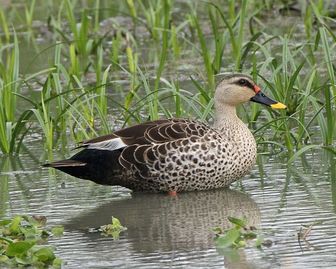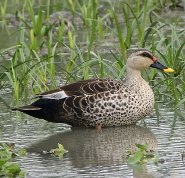Spot-billed duck
This duck is resident in the southern part of its range from Pakistan and India to southern Japan, but the northern subspecies, the Chinese Spotbill , is migratory, wintering in southeast Asia. It is quite gregarious outside the breeding season and forms small flocks. The northernmost populations have been expanding their range northwards by more than 500 km since the early 20th century, possibly in reaction to global warming . These are Mallard-sized mainly grey ducks with a paler head and neck and a black bill tipped bright yellow. The wings are whitish with black flight feathers below, and from above show a white-bordered green speculum and white tertials. The male has a red spot on the base of the bill, which is absent or inconspicuous in the smaller but otherwise similar female. Juveniles are browner and duller than adults.

Original source: originally posted to Flickr as Spot-billed Duck (Anas poecilorhyncha)
Author: Lip Kee YapPermission(Reusing this file)This image, which was originally posted to Flickr.com, was uploaded to Commons using Flickr upload bot on 12:00, 31 October 2008 (UTC) by Snowmanradio (talk). On that date it was licensed under the license below. This file is licensed under the Creative Commons Attribution-Share Alike 2.0 Generic license.You are free:to share – to copy, distribute and transmit the work
The Spot-Billed Duck has it right on the nose!
 The Spot-Billed Duck (Anas poecilorhyncha) is known by many names including the Yellow-Nib, Indian Spot-Billed, Spotbill and Chinese Spotbill, as well as being locally known as Garm Pai or Gugral. Its name comes from the red spots at the base of their yellow-tipped black bills, which the females of the species lack.
The Spot-Billed Duck (Anas poecilorhyncha) is known by many names including the Yellow-Nib, Indian Spot-Billed, Spotbill and Chinese Spotbill, as well as being locally known as Garm Pai or Gugral. Its name comes from the red spots at the base of their yellow-tipped black bills, which the females of the species lack.
Spot-bills are native to Asia, being found largely in Haryana, India, but also in China, Japan and the USSR. They live in freshwater lakes, ponds, rivers and marshes and are normally found in waters with a depth of 0-1,867 meters or 0-6,125 feet.
They nest on dry ground on top of piles of thick moss, grass, feathers and/or down. Relationships in this species are monogamous and females will lay 7-10 white colored eggs that she incubates for 26-30 days. These ducks are known to hybridize (mate with other similar species of duck) naturally with mallards and in captivity, with the Pacific Black Duck and the Philippine Duck. Breeding season differs between north and south India and with water levels: i.e. from July to October in Northern India and November to December in Southern India.
Both genders are similar in appearance having scaled brown bodies, a blue speculum with white borders on their wings, a dark brown crown, nape and eye stripe and orange legs and feet. They are a rather large species with a length ranging from 53-58 centimeters or 21-23 inches and a height of 40-81 centimeters or 16-32 inches. They have a tapered wing shape with a wingspan range of 76-94 centimeters or 30-33 inches and a fan-shaped tail. Juveniles tend to be an overall gray color.
These ducks are "dabbling ducks" meaning that they do not dive for their meals but instead stick their heads underwater with their tails in the air to forage. Spot-Billed Ducks will also graze on dry land for their food. They eat seeds, snails, grasses and aquatic plants and normally weigh about 62 grams or 2.2 ounces. They are also considered to be very social ducks and can sometimes be found in groups as large as 50 or more.
The Spot-Billed Duck has a rating of "Least Concern" on the endangered species list due to its wide range and population. Some predators of this duck would be large fish, such as the European Pike, foxes and snakes, which mostly threaten the eggs while in the nests and newly hatched ducklings.
Picture of the Spot-billed duck by Lip Kee Yap, licensed under the Creative Commons Attribution-Share Alike 2.0 Generic license.
The Spot-billed duck is classified as Least Concern. Does not qualify for a more at risk category. Widespread and abundant taxa are included in this category.

Original source: Blake Matheson
-Blake Matheson -Author: Blake Matheson
Permission: Some rights reserved
Family : Anatidae
Genus : Anas
Species : poecilorhyncha
Authority : Forster, 1781
